
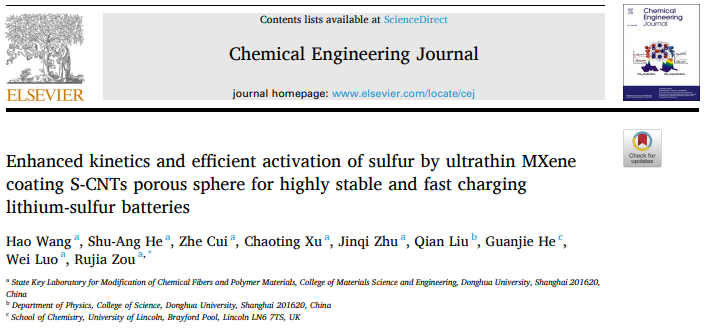

In recent years, the rapid development of consumer electronics and electric vehicles has increased the demand for large-capacity fast-charge batteries. Lithium-sulfur battery has become one of the most promising next-generation energy storage devices due to its ultra-high theoretical energy density (2600Wh kg-1), low sulfur toxicity, large quantity and low price. It is also one of the most promising next-generation energy storage devices. Research hotspots. However, lithium-sulfur batteries have several serious problems that restrict their applications: (1) the inherent insulation of elemental sulfur; (2) the shuttle effect of polysulfides (LiPSs) in the charge-discharge reaction; (3) the problem of electrode volume expansion. These have caused the reaction kinetics of the lithium-sulfur battery to be very slow, and the utilization rate of active sulfur is extremely low.
In order to solve the above-mentioned problems, a reasonably structured sulfur-carrying composite cathode has become the simplest and most effective method. In general, adding high-conductivity carbon-based materials (such as carbon nanotubes CNT) can improve the conductivity of the electrode, but carbon is a non-polar material, and its effect on polysulfides is limited to physical adsorption, which is difficult to alleviate serious shuttles. problem. Recently, Ti3C2Tx MXene has attracted the attention of scientific researchers due to its good electrical conductivity, modifiable surface, large two-dimensional specific surface area, and low lithium ion diffusion barrier. However, during preparation, MXene is very prone to self-stacking, loses specific surface area and a large number of active sites on the surface, and prolongs the lithium ion diffusion channel, which becomes a difficult problem in the application of MXene. Therefore, constructing a three-dimensional S/CNT/MXene complex is a reasonable idea to solve the above problems.
Recently, Zou Rujias research group at Donghua University used a simple and green method to construct the S-CNT@MXene three-dimensional cage-like composite. Firstly, Na2S4 was used to synthesize 5-8 nm ultrafine sulfur particles in situ on the surface modified CNTs. Under the action of stirring force, S-CNTs porous microspheres were formed, and then coated with a layer of ultra-thin MXene to form S- CNT@MXene three-dimensional cage structure. The in-situ synthesized sulfur nanoparticles are uniformly dispersed, avoiding the bulk sulfur caused by conventional melting sulfur filling, and improving the utilization rate of sulfur. The highly conductive network composed of carbon nanotubes can quickly and directly transport electrons and ions to active sulfur, which improves the reaction kinetics rate. Only 1-2 layers of ultra-thin MXene greatly improves the utilization of surface groups, and -OH, -O and other groups can effectively adsorb polysulfides. On the whole, the three-dimensional structure avoids the stacking problem of MXene and provides a fast channel for the rapid transmission of lithium ions. Combined with symmetrical battery CV curve, dynamic EIS and other tests, it shows the excellent performance of S-CNT@MXene. A high specific capacity of 1375.1 mAh g-1 is obtained at a small current of 0.1C; a reversible capacity of 557.3 mAh g-1 is still obtained at an ultra-large rate of 8.0C; 150 cycles of charging and discharging at a large current of 4.0C, the battery capacity remains The rate is close to 100%.
 The results were published in the internationally renowned journal Chemical Engineering Journal (impact factor 10.652) with the title: Enhanced kinetics and efficient activation of sulfur by ultrathin MXene coating S-CNTs poroussphere for highly stable and fast charging lithium-sulfur batteries. Dr. Wang Hao is the article No. One author.
The results were published in the internationally renowned journal Chemical Engineering Journal (impact factor 10.652) with the title: Enhanced kinetics and efficient activation of sulfur by ultrathin MXene coating S-CNTs poroussphere for highly stable and fast charging lithium-sulfur batteries. Dr. Wang Hao is the article No. One author.

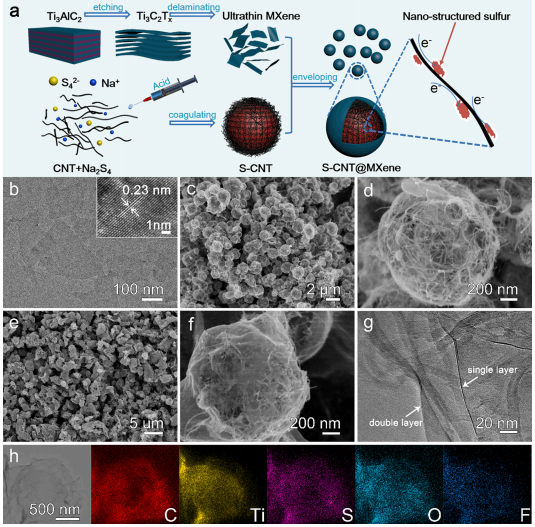
Figure 1. Schematic diagram of preparation and morphology of S-CNT@MXene. (A) Schematic diagram of preparation of S-CNT@MXene cage structure. (B) TEM image and illustrated HRTEM image of ultra-thin Ti3C2TxMXene. (C,d) SEM images of S-CNT balls under different magnifications. (E, f) SEM images of S-CNT@MXene at different magnifications. (G) HRTEM image of S-CNT@MXene. (H) EDX element analysis image of S-CNT@MXene.
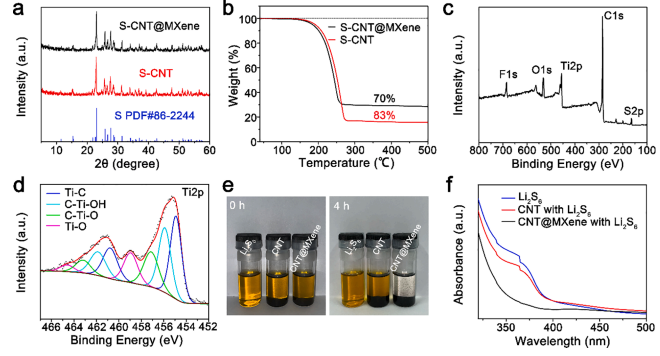 Figure 2. Phase analysis and adsorption test of S-CNT@MXene. (A) XRD patterns of S-CNT@MXene, S-CNT and commercial sulfur. (B) S-CNT@MXene, the thermogravimetric curve of S-CNT. (C) XPS total spectrum of S-CNT@MXene. (D) Fine spectrum of Ti element of S-CNT@MXene. (E, f) Visual adsorption test and corresponding UV/vis spectrum.
Figure 2. Phase analysis and adsorption test of S-CNT@MXene. (A) XRD patterns of S-CNT@MXene, S-CNT and commercial sulfur. (B) S-CNT@MXene, the thermogravimetric curve of S-CNT. (C) XPS total spectrum of S-CNT@MXene. (D) Fine spectrum of Ti element of S-CNT@MXene. (E, f) Visual adsorption test and corresponding UV/vis spectrum.
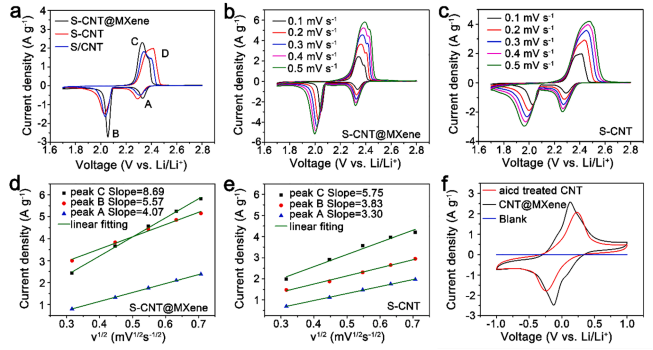 Figure 3. CV spectrum of S-CNT@MXene, S-CNT, S/CNT, CV spectrum of symmetric battery. (A) CV comparison chart of S-CNT@MXene, S-CNT, S/CNT. (B,c) S-CNT@MXene, CV spectra of S-CNT at different scanning speeds. (D,e) S-CNT@MXene, the corresponding I-v2 diagram of the S-CNT CV diagram with different scanning speeds. (F) CV spectrum of symmetrical battery.
Figure 3. CV spectrum of S-CNT@MXene, S-CNT, S/CNT, CV spectrum of symmetric battery. (A) CV comparison chart of S-CNT@MXene, S-CNT, S/CNT. (B,c) S-CNT@MXene, CV spectra of S-CNT at different scanning speeds. (D,e) S-CNT@MXene, the corresponding I-v2 diagram of the S-CNT CV diagram with different scanning speeds. (F) CV spectrum of symmetrical battery.
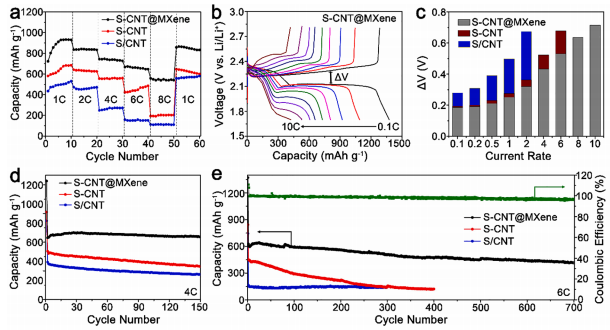 Figure 4. Electrochemical performance test. (A) S-CNT@MXene, S-CNT, S/CNT rate performance. (B) Charge and discharge curves of S-CNT@MXene at different rates. (C) Polarization comparison of S-CNT@MXene, S-CNT, and S/CNT. (D,e) S-CNT@MXene, S-CNT, S/CNT cycle performance under 4.0C and 6.0C.
Figure 4. Electrochemical performance test. (A) S-CNT@MXene, S-CNT, S/CNT rate performance. (B) Charge and discharge curves of S-CNT@MXene at different rates. (C) Polarization comparison of S-CNT@MXene, S-CNT, and S/CNT. (D,e) S-CNT@MXene, S-CNT, S/CNT cycle performance under 4.0C and 6.0C.
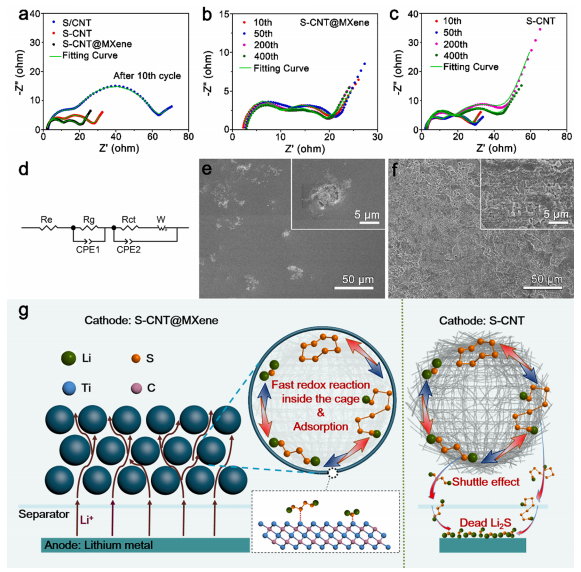 Figure 5. Dynamic EIS diagram, characterization and mechanism diagram of negative electrode lithium after cycling. (A) EIS comparison of S-CNT@MXene, S-CNT, S/CNT after 10 cycles. (B,c) S-CNT@MXene, S-CNTs EIS is compared with the dynamic changes of the cycle. (D) Fitting circuit diagram. (E, f) S-CNT@MXene, SEM image of the corresponding negative lithium sheet after S-CNT cycling. (G) Electrochemical mechanism diagram.
Figure 5. Dynamic EIS diagram, characterization and mechanism diagram of negative electrode lithium after cycling. (A) EIS comparison of S-CNT@MXene, S-CNT, S/CNT after 10 cycles. (B,c) S-CNT@MXene, S-CNTs EIS is compared with the dynamic changes of the cycle. (D) Fitting circuit diagram. (E, f) S-CNT@MXene, SEM image of the corresponding negative lithium sheet after S-CNT cycling. (G) Electrochemical mechanism diagram.
 In this paper, a simple and energy-saving method was used to prepare a new three-dimensional cage-like structure of S-CNT@MXene, which is used as a cathode material for lithium-sulfur batteries. The ultrafine sulfur nanoparticles synthesized in situ avoid the problem of low utilization rate of bulk sulfur. The highly conductive network composed of carbon nanotubes enhances the overall conductivity. The ultra-thin MXene layer on the surface is not only for inhibiting the shuttle of polysulfides. The protective layer can also catalyze the rapid conversion of polysulfides, accelerate the nucleation and decomposition of lithium sulfide, and promote the transmission rate of lithium ions. Ingenious structural design, the multi-step complex electrochemical reaction of the lithium-sulfur battery can be carried out quickly and effectively inside the cage, so that it can obtain excellent electrochemical performance, especially the ability of rapid charge and discharge under high current. This research shows that a reasonable structural design is of great significance for improving the sulfur utilization rate of lithium-sulfur batteries and for the application of lithium-sulfur battery fast charging.
【author information】
Corresponding author: Zou Jia Ru associate professor, doctoral tutor, Shanghai Pujiang scholars, Hong Kong scholar, has been working on nanomaterials TEM performance and lower monomer components, energy storage materials. Published more than 100 SCI papers in well-known academic journals such as Prog. Mater. Sci., Acc. Chem. Res., Adv. Mater., Nano Lett., and more than 20 articles were selected as hot spots of the magazine and Top Ten download articles after publication. , The article has been cited more than 7,400 times, H-index: 45. 12 authorized patents. Presided over and participated in more than 20 national, provincial and ministerial fund projects such as the National Natural Science Foundation of China, the 863 Project, the Ministry of Education Major, and the Ministry of Education’s "Innovative Team Development Plan".
Author: Wang Hao, School of Materials Science and Engineering, Donghua University doctoral
Literature link: https://doi.org/10.1016/j.cej.2021.129693
In this paper, a simple and energy-saving method was used to prepare a new three-dimensional cage-like structure of S-CNT@MXene, which is used as a cathode material for lithium-sulfur batteries. The ultrafine sulfur nanoparticles synthesized in situ avoid the problem of low utilization rate of bulk sulfur. The highly conductive network composed of carbon nanotubes enhances the overall conductivity. The ultra-thin MXene layer on the surface is not only for inhibiting the shuttle of polysulfides. The protective layer can also catalyze the rapid conversion of polysulfides, accelerate the nucleation and decomposition of lithium sulfide, and promote the transmission rate of lithium ions. Ingenious structural design, the multi-step complex electrochemical reaction of the lithium-sulfur battery can be carried out quickly and effectively inside the cage, so that it can obtain excellent electrochemical performance, especially the ability of rapid charge and discharge under high current. This research shows that a reasonable structural design is of great significance for improving the sulfur utilization rate of lithium-sulfur batteries and for the application of lithium-sulfur battery fast charging.
【author information】
Corresponding author: Zou Jia Ru associate professor, doctoral tutor, Shanghai Pujiang scholars, Hong Kong scholar, has been working on nanomaterials TEM performance and lower monomer components, energy storage materials. Published more than 100 SCI papers in well-known academic journals such as Prog. Mater. Sci., Acc. Chem. Res., Adv. Mater., Nano Lett., and more than 20 articles were selected as hot spots of the magazine and Top Ten download articles after publication. , The article has been cited more than 7,400 times, H-index: 45. 12 authorized patents. Presided over and participated in more than 20 national, provincial and ministerial fund projects such as the National Natural Science Foundation of China, the 863 Project, the Ministry of Education Major, and the Ministry of Education’s "Innovative Team Development Plan".
Author: Wang Hao, School of Materials Science and Engineering, Donghua University doctoral
Literature link: https://doi.org/10.1016/j.cej.2021.129693












